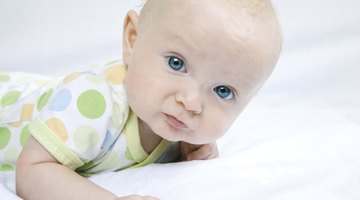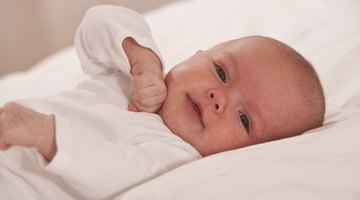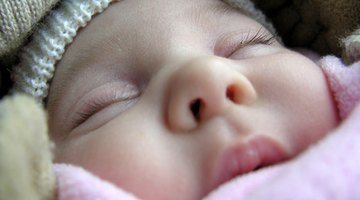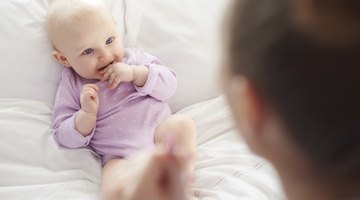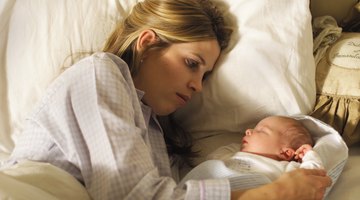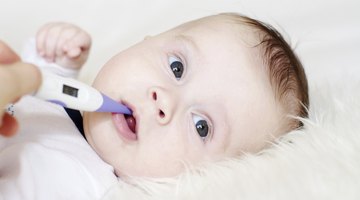Baby Concussion Symptoms
No matter how vigilant you are, accidents happen, and babies sometimes sustain bumps on the head. When these incidents occur, worry about a possible concussion or more serious brain injury often follows. A concussion refers to a mild brain injury that temporarily disrupts normal brain function. This injury typically occurs when a baby sustains a blow to the head, often due to a fall or getting hit on the noggin with a hard object.
Detecting symptoms of a concussion in babies is trickier than in older children or adults because infants cannot express what they’re experiencing. However, there are signs and symptoms you can look for that might raise suspicion for a concussion.
Loss of Consciousness
Loss of consciousness, or being temporarily knocked out, strongly suggests the possibility of a concussion in anyone who experiences a head injury -- regardless of age. Sustained loss of consciousness is easy to detect, with a complete lack of responsiveness. However, unconsciousness often occurs for only a few seconds and can be difficult to detect in a baby.
If your baby begins crying immediately after a blow to the head, you can be reasonably certain that there was no loss of consciousness. Flailing of the baby’s arms or legs immediately after the incident also suggests there has been no loss of consciousness. But if the baby seems to go limp or appears unresponsive for a few seconds, your little one may have briefly lost consciousness.
Altered Mental Status

Signs of Head Trauma to a Baby
Learn More
Altered mental status encompasses a broad range of signs and symptoms caused by impaired brain function. A change in mental status after a blow to the head typically signals a concussion or possibly a more severe brain injury. These signs and symptoms can occur immediately after the injury or develop hours afterward.
Altered mental status in babies can manifest in several ways, including: -- Inconsolable crying. -- Appearing dazed. -- Reduced eye contact. -- Reduced responsiveness to your voice or favorite toys. -- Sluggishness or excessive drowsiness. -- Difficulty arousing the baby from sleep. -- Sleeping more or less than usual. -- Increased fussiness, agitation or irritability. -- Lack of interest in nursing or eating. -- Unusual sensitivity to light or sound.
Physical Signs and Symptoms
The development of a lump or bruise on your baby’s head after a fall or another accident can increase the suspicion for a possible concussion -- although it is by no means a certainty. Concussions typically occur with a relatively forceful blow to the head, and the development of a lump or bruise is one indicator of the force of the impact. Repeated vomiting is another possible physical symptom of a concussion in a baby. Keep in mind that spitting up, which is very common in infants, differs from vomiting. Vomiting is characteristically more forceful than spitting up.
Warnings and Precautions
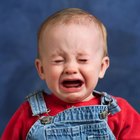
My Baby Hit His Head: What Should I Do?
Learn More
Diagnosing a concussion is challenging in babies, even for seasoned healthcare professionals. If your baby sustains anything more than a light bump on the head, call the child’s doctor right away to determine next steps.
This is especially important if your baby is younger than 1 year, has fallen from a height of 3 feet or more, or has any signs or symptoms that might indicate a concussion. Evaluation by a doctor is often necessary to determine whether the baby has sustained a concussion or another brain injury.
Seek emergency medical care for your baby if any head injury danger signs occur, including: -- Pupils are not the same size. -- Clear fluid or blood drains from the ears or nose. -- Head appears misshapen. -- Seizure after the accident. -- Bulging of the baby’s soft spot. -- Loss of consciousness for more than a few seconds. -- Sweating and paleness. -- Difficulty arousing a response from the baby after the incident. -- Altered breathing.
Related Articles
- Centers for Disease Control and Prevention: Facts About Concussion and Brain Injury
- Maternal-Child Nursing Care: Optimizing Outcomes for Mothers, Children and Families, 2nd Edition; Susan Ward and Shelton Hisley
- Child Neurology, 7th Edition; John H. Menkes et al.
- Family Practice Notebook: Head Injury CT Indications in Children
- Color Atlas of Emergency Trauma, 2nd Edition; Demetrios Demetriades and Edward Newton
- Textbook of Pediatric Emergency Medicine, 6th Edition; Gary R. Fleisher and Stephen Ludwig
- Pediatric Clinics of North America: Pediatric Minor Closed Head Injury
- Pediatric and Adolescent Concussion: Diagnosis, Management, and Outcomes; Jennifer Niskala Apps and Kevin D. Walter


